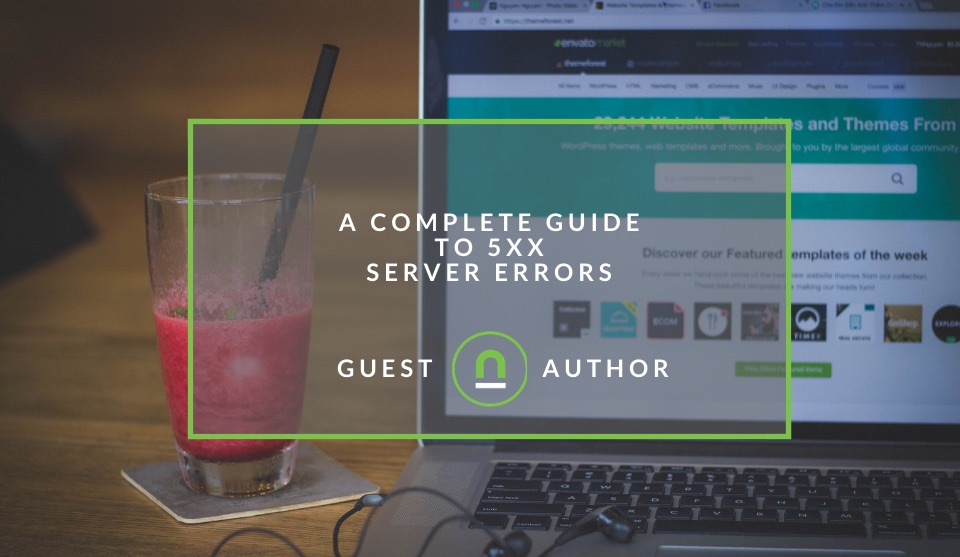Recent posts

Industry Experts
Common ASO Mistakes African App Developers Make
09 January 2026

Ace of Trades
The South African Industrial Tech Revolution
05 January 2026

nichemarket Advice
Why Video Production Companies Still Outshine AI
24 December 2025

Press Releases
Where You Can Find International Remote Jobs For South Africans
23 December 2025
Popular posts
Extravaganza
Trending Music Hashtags To Get Your Posts Noticed
24 August 2018
Geek Chic
How To Fix iPhone/iPad Only Charging In Certain Positions
05 July 2020
Extravaganza
Trending Wedding Hashtags To Get Your Posts Noticed
18 September 2018
Money Talks
How To Find Coupons & Vouchers Online In South Africa
28 March 2019
A Complete Guide to 5xx Server Errors
05 November 2019 | 0 comments | Posted by Natalya Dyatko in Industry Experts
"Bad Gateway", "Internal Server Error", "xxx" - we've all seen these errors hundreds of times. If you encounter them while browsing, don't panic: there's nothing wrong with your device. In this guide, I'll tell you what 500 errors mean – and how to get past them.
What is the server trying to tell you?
Before I discuss each of the 500's error messages in detail, let's refresh some HTTP basics. Every website is hosted – that is, "lives" - on a server. In the vast majority of cases, site owners rent server space from a web hosting company.
It's the host's job to perform hardware maintenance and ensure server security. When you enter an URL in your browser address bar, you are sending a sort of an instant message to the server on the other side.
The server receives your request and thinks about it for a little bit. This is called response time. Finally, after 0.5-0.7 second or so (for fast servers), it starts to serve your data — the page loads. Only in the case of 5xx server errors, it doesn't. The server runs into an error of some kind and can't send you the page you want.
An error message is its way to say, "Oops, I'm sorry, something went wrong". The exact code of the error is how the server tries to explain what the problem is. Now that you know where 5xx errors come from let's look at each of them in turn.
Know your enemy
500: Internal Server Error
A 500 error is the most generic of the set. The server encountered an internal error and can't complete your request – that's all it knows. For WordPress sites, 500 often means that there's a faulty plugin, a bug in the .htaccess file or a theme issue. Also, sites that use shared hosting tend to produce 500 errors when they are out of memory.
501: Not Implemented
The server doesn't support some technical functionality it needs to complete your request. Perhaps it needs a software update. It can also be a temporary overload, though.
502: Bad Gateway
Often the server you are connected to has to go to yet another server to fetch the data you want. It acts as an intermediate or proxy – that's what is meant by "gateway". A 502 code tells you that the gateway sent your request to the target server – but the response it received was invalid. Maybe the target server is dealing with too many requests, or there is a firewall issue or a bug in the coding.
503: Service Unavailable
This means that the server is currently unavailable. It just doesn't respond to your request. One of the most common reasons is scheduled maintenance. But it can also happen that the server is getting a large number of requests and can't handle yours at the moment.
504: Gateway Timeout
The 504 error is very similar to 502: in both cases, you are dealing with a proxy server. The difference is that in 502, your gateway receives an invalid response, but in 504, it receives no response at all. The gateway waits for the set amount of time – but nothing comes from the other side.
Fixing 500 errors
There is no specific solution for each of the errors. The fixes I list here can help with all 5xx errors, so try them one by one.
1) Refresh the page
Use the refresh icon in your browser or the F5 key on your keyboard. You can also use the hotkey combination Ctrl+R (Command+R on Mac).
2) Use an online tool
3) Restart your browser
Close your browser window and all your tabs. Then open it again and try to re-enter the URL.
4) Clear browser cache
Your browser stores a lot of files to make surfing faster, but some of those files can contain errors. See this guide on how to remove cache from different browsers.
Chrome's settings to clear cache and cookies
5) Open the page in a different browser
Sometimes your browser may think that something's wrong with a site when in fact everything's fine. Browsers make mistakes, too! So if you are using Chrome, for example, try Firefox, Safari, Edge, or Brave.
6) Restart your device
There could be a glitch with your wifi antenna or router. Restart your phone or laptop and see if it helps.
7) Try Safe Mode
Many browsers have a safe mode that disables all extensions and non-essential settings. If the page loads in Safe Mode, it means that one of your add-ons is the culprit. Learn how to enter Safe Mode in Chrome, Firefox, and Safari.
8) Remove cookies
First, try to delete the cookies about the site you are trying to access. If this doesn't help, you can remove them all. Keep in mind: if you do this, you'll be signed out of all the websites you use.
9) Try later
Most 5xx issues are resolved within a few hours. - And only a few are permanent. If it's nothing urgent, just come back after a while and reload the page.
10) Get in touch with your ISP
By this point, you've established that the site is up and your browser & hardware are working correctly. The problem could lie with your Internet Service Provider, so give them a call.
11) Contact the website
Website owners often have permanent 5xx errors they never knew are live. You'll do the admin an excellent service by alerting them so that they can notify their web hosting company.
The bottom line
In this guide, I focused on 500 errors as viewed from the side of the user. Things are different if you are a website owner and have a permanent 500 error. You'll need to do some detailed troubleshooting to get to the cause.
About the author
Natalya Dyatko is a freelance writer and content marketing/SEO specialist. Follow her on Linkedin and Twitter for more SEO tips, tutorials, and analysis.
Tell us your story
Would you like to write for nichemarket just like Natalya has? Find out how to submit a guest post and when you're ready, you can contact us.
Are you looking to promote your business?
South African businesses can create your free business listing on nichemarket. The more information you provide about your business, the easier it will be for your customers to find you online.
Registering with nichemarket is easy; all you will need to do is head over to our sign up form and follow the instructions. If you require a more detailed guide on how to create your profile or your listing, then we highly recommend you check out the following articles.
Recommended reading
If you enjoyed this post and have time to spare why not check out these related posts and dive deeper down the rabbit hole that is Website management.
You might also like
Building Trust In Online Marketplaces Through Better Verification
17 December 2025
Posted by Jay Stone in Shopaholics
Learn how advanced verification methods build trust in online marketplaces, protect users from fraud, and ensure a secure, reliable digital trade env...
Read moreCommon ASO Mistakes African App Developers Make
09 January 2026
Posted by Daniel Davis in Industry Experts
ASO is Localisation, Not Translation: Failing to research specific local search terms and cultural nuances is the biggest ASO error in African market...
Read more{{comment.sUserName}}
{{comment.iDayLastEdit}} day ago
{{comment.iDayLastEdit}} days ago
 {{blogcategory.sCategoryName}}
{{blogcategory.sCategoryName}}

